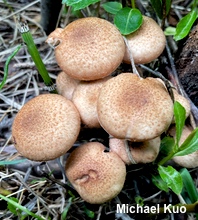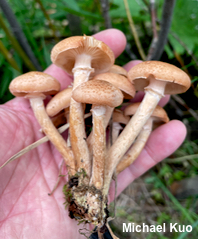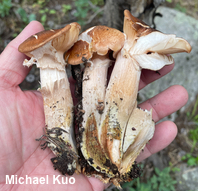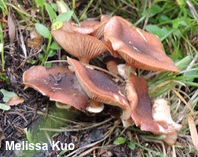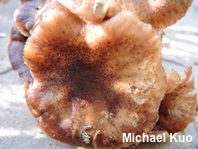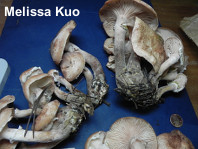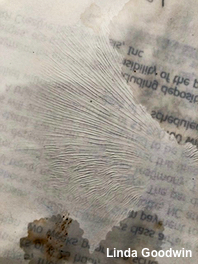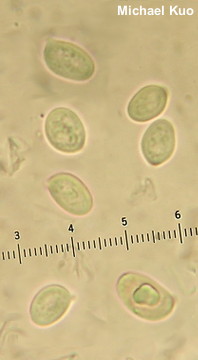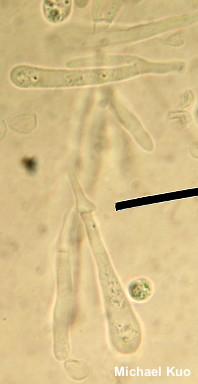| Major Groups > Gilled Mushrooms > Pale-Spored > Armillaria > Armillaria solidipes |

|
[ Basidiomycota > Agaricales > Physalaciaceae > Armillaria . . . ] Armillaria solidipes by Michael Kuo, 30 November 2023 In most areas of North America, Armillaria solidipes can be separated from other species of Armillaria on the basis of its brown colors, the fairly prominent scales featured on its cap, and the well developed ring on its stem. It is usually found on the wood of conifers, and it is a ravaging parasite feared by forest managers across the continent. In the northeast, from about New Hampshire to North Carolina, the hardwood-loving and apparently benign Armillaria gemina is a "morphologically inseparable" species—which means there is no way to distinguish it from Armillaria solidipes by looking at it (with or without a microscope). However, the two species are unable to "mate" with each other, and are thus clearly distinct—though you may need a mycological laboratory and training in order to figure out which Armillaria you have collected. In the western United States, Armillaria altimontana is another virtually inseparable species; it appears to be limited to interior forests at higher elevations where fir is present, and it often has a swollen stem base. However, Armillaria solidipes can also be found in fir forests at high elevations, and its stem base is not always narrowed. Ultimately, mating or DNA testing may be required to reliably separate Armillaria altimontana from Armillaria solidipes. Burdsall & Volk (2008) determined through morphological analysis that the 100-year-old type collection of Charles Peck's Armillaria solidipes represented the same species as Armillaria ostoyae, named by Romagnesi in 1970; by the rules of nomenclature the older name, the authors argued, took precedence. However, more recent research (Klopfenstein et al. 2017, Sahu et al. 2023) supports the idea that solidipes and ostoyae are distinct phylogenetic species that are also separated by the Atlantic Ocean. A 2007 study by Hanna and collaborators found three phylogeographic "groups" within North American collections of Armillaria solidipes: a circumboreal group, a group in the Rocky Mountains, and a Pacific Northwest group. The ranges of these groups sometimes overlap, and the researchers found that hybridization also occurs between groups. Thanks to Linda Goodwin for documenting, collecting, and preserving Armillaria solidipes for study; her collection is deposited in The Herbarium of Michael Kuo. Description: Ecology: Parasitic and saprobic on the wood and roots of conifers (including spruces, pines, and hemlocks) and, less frequently, hardwoods (especially aspens and birches within conifer forests, but also documented on black oak); causing a root rot; typically growing in dense clusters; summer and fall; originally described from Colorado (Peck 1900); widely distributed in North America. The illustrated and described collections are from California, Colorado, and North Carolina. Cap: 3–10 cm; convex at first, becoming broadly convex or nearly flat in age; dry or slightly moist; dark brown to pinkish brown, cinnamon brown or yellow-brown underneath small, tan to brown or blackish scales; the margin sometimes becoming finely lined. Gills: Broadly attached to the stem or beginning to run down it; close or nearly distant; short-gills frequent; white or whitish when young and fresh, developing pinkish hues and/or reddish brown spots and discolorations. Stem: 5–10 cm long; 0.5–2 cm thick; more or less equal, or slightly tapered to base; whitish, becoming brownish to yellowish, gray, or nearly black toward the base; finely hairy with brownish fibrils; with a well-developed whitish ring that may feature a yellowish or brownish underside or edge; usually with yellowish mycelium near the base; attached to long black rhizomorphs that run through the wood. Flesh: Whitish, sometimes becoming pinkish brown with maturity; often yellow in the stem base; unchanging when sliced. Odor and Taste: Odor not distinctive; taste mild to slightly bitter. Chemical Reactions: KOH on cap surface negative. Spore Print: White. Microscopic Features: Spores 7–10.5 x 4–6.5 µm; ellipsoid; smooth; hyaline in KOH; inamyloid. Basidia 30–35 x 4–6 µm; clavate; often basally clamped; 4-spored. Cheilocystidia ("marginal cells") inconspicuous; 15–25 x 2.5–5 µm; cylindric-flexuous, subclavate, or subfusiform; thin-walled; hyaline in KOH. Pleurocystidia not found. Pileipellis a cutis; golden brownish in KOH; elements 5–10 µm wide, smooth; terminal cells cylindric with rounded apices. REFERENCES: C. H. Peck, 1900. (Moser, 1983; Berube & Dessureault, 1988; Volk, 2003; McNeil, 2006; Miller & Miller, 2006; Hanna et al, 2007; Burdsall & Volk, 2008; Trudell & Ammirati, 2009; Brazee & Wick, 2011; Hunt et al., 2011; Evenson, 2015; Siegel & Schwarz, 2016; Klopfenstein et al., 2017; Sturgeon, 2018; Caballero et al., 2023; Kim et al., 2023; Sahu et al., 2023.) Herb. Kuo 08180703, 01161501, 08131509, 09241803, 07292103, 07292104, 01312301; Herb. DBG ROMO 2012 5024-34, 5025-34, 5026-14, 5026-25, 5027-24, 5027-31. This site contains no information about the edibility or toxicity of mushrooms. |
© MushroomExpert.Com |
|
Cite this page as: Kuo, M. (2023, November). Armillaria solidipes. Retrieved from the MushroomExpert.Com Web site: http://www.mushroomexpert.com/armillaria_solidipes.html |
